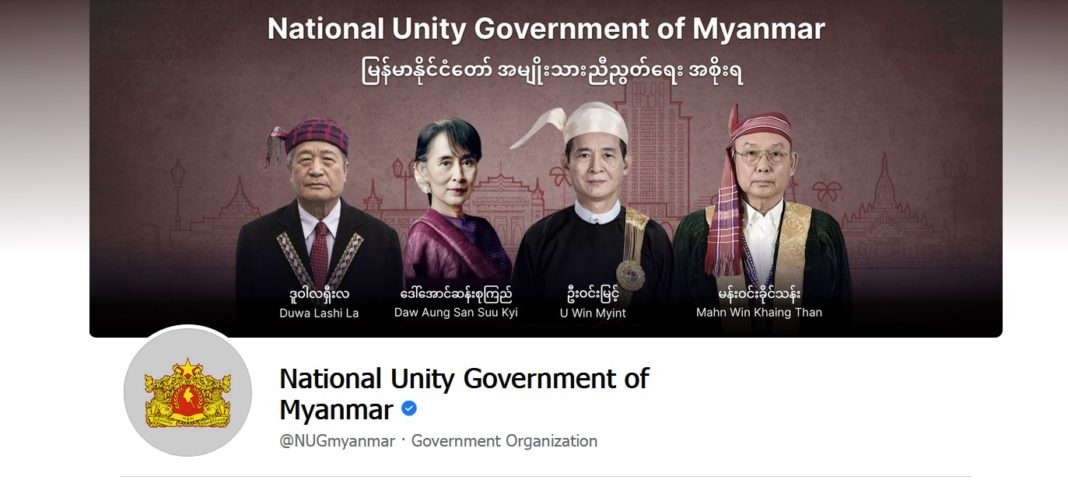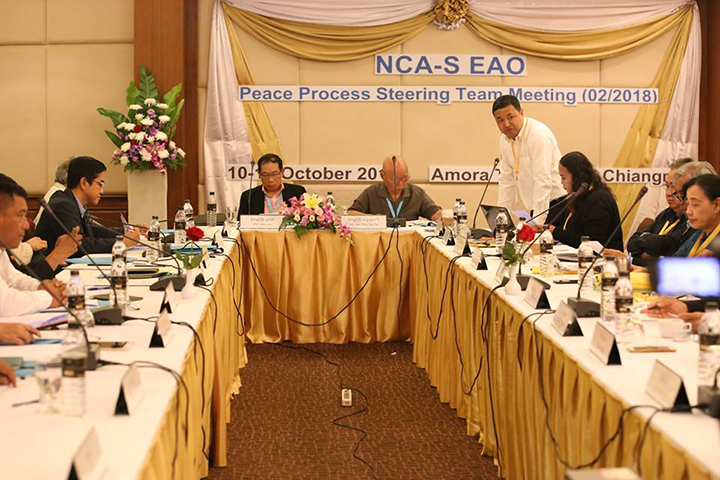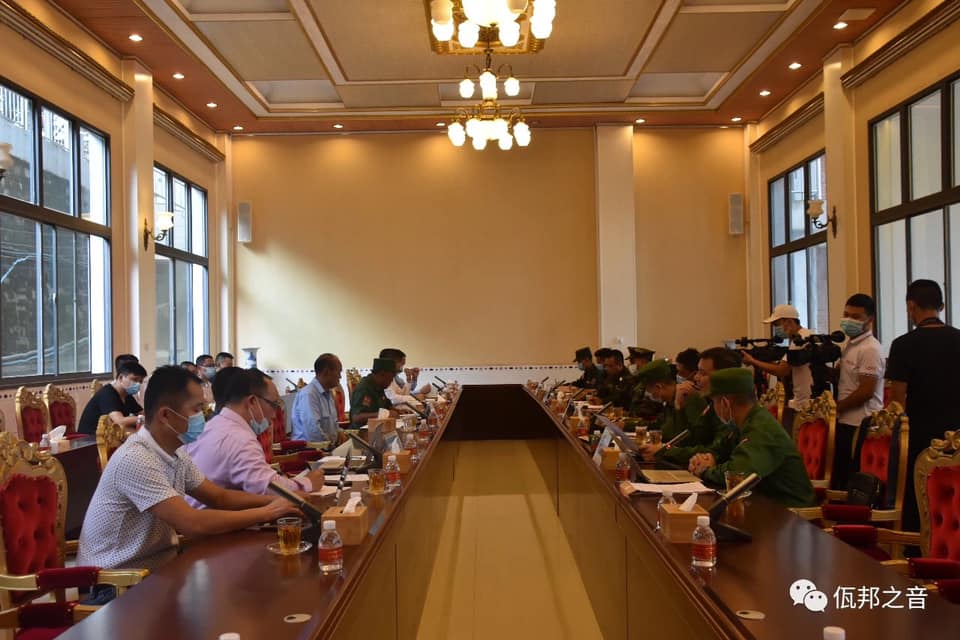On April 16, National Unity Government (NUG) was formed, reportedly after intensive discussion among the National Unity Consultative Council (NUCC) members of whom the identities are not publicized. It is also not clear if the NUCC is already formed as one Chin National Front (CNF) leader Salai Lian Hmung Sakhong, recently appointed federal union affairs minister, said recently that it will be officially formed soon.
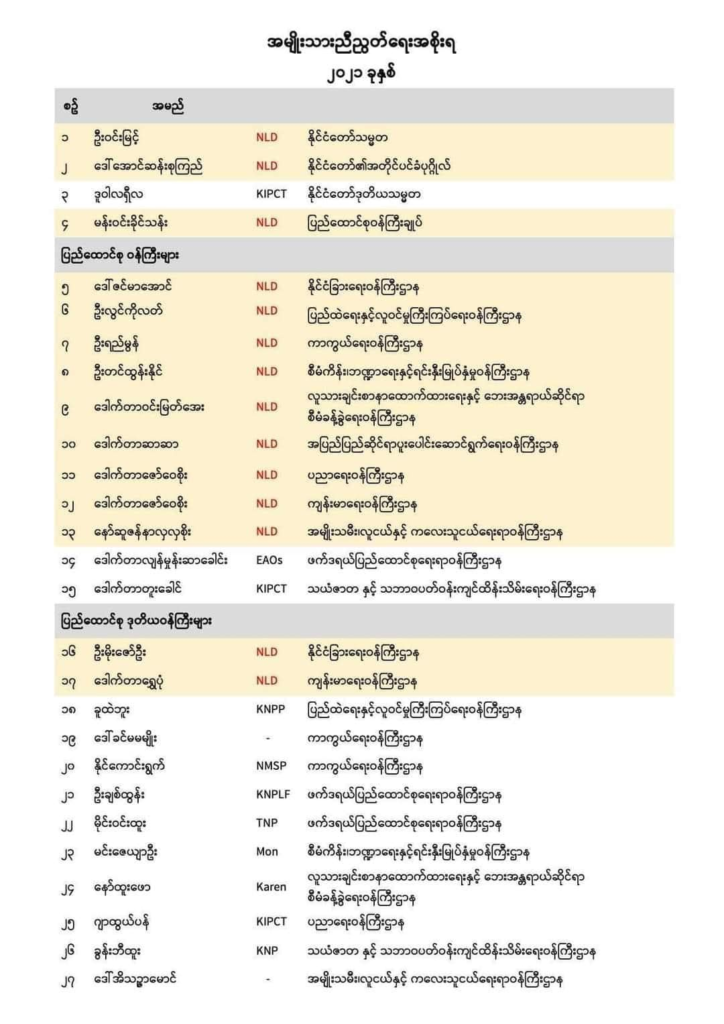
The idea to form NUG is an excellent thinking mode but a few basic understanding has to be in place, in order to be effective and cater to the widest possible range of stakeholders or representatives representing the peoples or ethnic groups concerned.
First and foremost, the members of the NUG have to be chosen from organizations and not cherry picking individuals from organizations without their consent, although this does not mean competent and committed patriots should not be recruited to join the fray.
Formation of the NUG is in many ways similar to the forming of coalition in normal times of any coalition government. It must have a coalition contract, which covers almost all issues that have to do with the governance of a country. This contract has to be ironed out so that during the legislature period the business of governing will have as little problem as possible, within the given constitution.
However, coalition government though similar to the NUG, is quite different in a lot of aspects in reality. The NUG is not just having a few coalition partners to govern which will have a majority vote within the parliament like in normal times but to cover, coordinate and cooperate with the widest range of stakeholder organizations, primarily political organizations, to salvage the country from falling into abyss, like we are facing now in Burma or Myanmar. In other words, NUG is generally formed to overcome either the natural disaster, pandemic, economic recession, or uncontrollable civil war, which could lead to a failed state. Burma now covers almost all the aspects mentioned and in short, NUG is a national emergency war time formation. As such, wholly banking on the electoral victory of NLD in November election of last year would not be an appropriate approach.
In the recent Burma’s case in order to avoid becoming a failed state, which led to the essential struggle to uproot the military dictatorial system, or should we say a social revolution, now popularly dubbed “Spring Revolution”, political stakeholders can be divided into armed and unarmed political organizations.
Armed organizations are some 20 ethnic armed organizations (EAOs), while unarmed are political organizations, including the Civil Society Organizations (CSOs) that are at the forefront of the Spring Revolution.
But let us first look at who the actors are in this ensuing conflict between the coup-maker military junta and the revolting people who are against its rule and sought to return to democratization process setting, which was abruptly stopped on its track because of the military coup staged on February 1, 2021.
Actors in the conflict
The State Administration Council (SAC) or coup-maker junta wants to cling to 2008 military-drafted Constitution and vowed to hold on to multi-party national election in a year, which now has been extended to two years. But nobody believes in it as it tries to disqualify the National League for Democracy (NLD) and its leaders by all means to reenter the election or political arena. Thus, it could be said that the junta will try to create a situation of 2011-2016 Union Solidarity and Development Party (USDP)-led Thein Sein era kind of government, which means the NLD will be left out or disbanded forever, with some multi-party trappings allowing some medium to small political parties to operate. In other words, it will be a military bloc one party rule, with perhaps some small opposition parties as show case that won’t be able to do much against its political hegemony.

2019 05 10 PPST Photo 
FPNCC meeting at Pangsang
The EAOs are divided into United Wa State Army (UWSA)-led and Nationwide Ceasefire Agreement-Signatory-EAOs (NCA-S-EAOs) groups. The former is politically under the alliance of Federal Political Negotiation and Consultative Committee (FPNCC), while the latter is represented by the Peace Process Steering Team (PPST) in deliberations and bargaining for political settlement with the government.
The peace negotiation process stopped when the military coup took place in February. However, regarding the NCA the 10 NCA-S-EAOs may have different interpretation on whether it is still valid or already defunct, as some want to cling to it as it gives them legitimacy to move around domestically and internationally, while the others take it as being irrelevant because the NCA is made up of four parties (government, military, EAOs and political parties) and now only the military and EAOs are left from the negotiation partners. Contractually, this situation makes the NCA automatically defunct because all stakeholders are no more present to make a deal.
The political alliance FPNCC is made up of United Wa State Army (UWSA), National Democratic Alliance Army (NDAA), Shan State Progressive Party (SSPP), Kachin Independence Army (KIA), Ta’ang National Liberation Army (TNLA), Myanmar National Democratic Alliance Army (MNDAA) and Arakan Army (AA).
Ten ethnic armed organizations signatory to the NCA are the Karen National Union (KNU), Chin National Front (CNF), All Burma Students Democratic Front (ABSDF), Karen National Liberation Army-Peace Council (KNLA/PC), Pa-O National Liberation Organization (PNLO), Arakan Liberation Party (ALP), Restoration Council of Shan State (RCSS), Democratic Karen Benevolent Army (DKBA), New Mon State Party (NMSP) and the Lahu Democratic Union (LDU).
The FPNCC members has two separate military alliances. One is the National Alliance-Burma (NA-B), which includes the KIA, AA, MNDAA or Kokang and TNLA. The second is called the Three Brotherhood Alliance, made up of the AA, MNDAA and TNLA, without the KIA.
A few weeks back the Three Brotherhood Alliance attacked a police station in Nawng Mawn, Lashio Township, killing a dozen of policemen and wounding a few of them. Thus, it could be said that that the alliance is openly against the SAC, while the UWSA, NDAA and SSPP are undecided as of this writing. A week ago the SAC led by Lieutenant General Yar Pyae was said to be wooing the three not to join the anti-junta camp.
Besides, the KIA has been actively engaged in military offensive shortly after the military coup and retook many of the outposts manned by the junta’s troops previously. Recent reports indicated that not less than ten military garrisons have been retaken by the KIA in Kachin State and northern Shan State. The military conflict is ongoing and tend to increase, as the junta tries to retake the lost outposts from the KIA.
From the PPST, only KNU has stepped up military operation against the junta and the latter has answered by air raids and bombardment in Karen State, particularly on civilian settlement prompting them to flee to the Thailand and border areas. KNU Brigade 5 has issued a statement that it supports the Committee Representing Pyidaungsu Hluttaw (CRPH) and the Civil Disobedience Movement (CDM) of the people.
Recently, RCSS bases in Loikaw Wan, Loi Taileang (GHQ) and Pang Mai Soong along the Thai-Shan State border were repeatedly bombarded by the military or Tatmadaw but RCSS hasn’t reacted to it so far. It hasn’t also made public of its position to the NUG formation. According to insider sources the military was said to be reacting as warnings to the RCSS, as it is not happy with the news that the RCSS has been giving military training to the CDM people, who are taking refuge in its areas. However, the RCSS rejected the accusation.
Meanwhile, on April 22 armed three clashes were reported by Shan News between the Tatmadaw and RCSS troops in Lang Khur, Loi Lem and Khesi districts. One Tatmadaw soldiers was said to have died in the clashes.
The most influential domestic organizations in this conflict situation are the General Strike Committee (GSC) and General Strike Committee of Nationalities (GSCN), although other CSOs are also crucial in their respective areas of concerned. GSC welcome the NUG formation and vowed to cooperate in making it all-inclusive.
Formation of NUG
The CRPH six-point press release dated April 16 stated:
- the formation of NUG;
- formation of NUG according to the NUCC suggestion;
- NUG will practically implement the Federal Democracy Charter;
- legislative pillar will be represented by CRPH, administrative pillar by NUG, and judiciary pillar will be formed and given duty;
- Regions and States parliamentary representative will be formed according to the wish of the people; and
- NUG will be widened and formed aiming to include all ethnic (Taingyinthar) peoples according to necessity.
NUG line up
In the NUG the NLD takes 14 places from the 27 available portfolios and 13 are divided among Kachin, Karen, Karenni, Mon, Chin and Ta’ang representatives. Most, except the Karen, have some sort of consultative council or committee umbrella organizations recently formed to speak for their respective ethnic groups.

All the top posts are occupied by the NLD, except for vice-president, which is given to a Kachin Duwa Lashi La.
Surprisingly, positions of President Win Myint and State Counselor Aung San Suu Kyi are maintained in the new government line up even though they are detained and charged by the junta government, begging the question on how they would be able to function at all, not to mention to participate effectively.
The prime minister is Mahn Win Khaing Than, who previously was an acting vice-president in CRPH acting government and before that was the speaker in House of Nationalities before the military coup.
The role of president and state counselor are also not clear given that in the parliamentary system the prime minister will be the main functioning leader of the government.
Further complaint making the rounds were the reappointment of Win Myat Aye as minister for social welfare, relief and resettlement because he was seen as anti-Rohingya when he was performing his task under the NLD-led government before the military coup.
Ethnic Consultative Councils
Before the formation of the NUG, the Kachin was the first to form the Kachin Political Interim Coordination Team (KPICT). This was followed by Ta’ang Political Consultative Committee (TPCC); Interim Chin National Consultative Council (ICNCC); and Karenni State Consultative Council (KSCC).
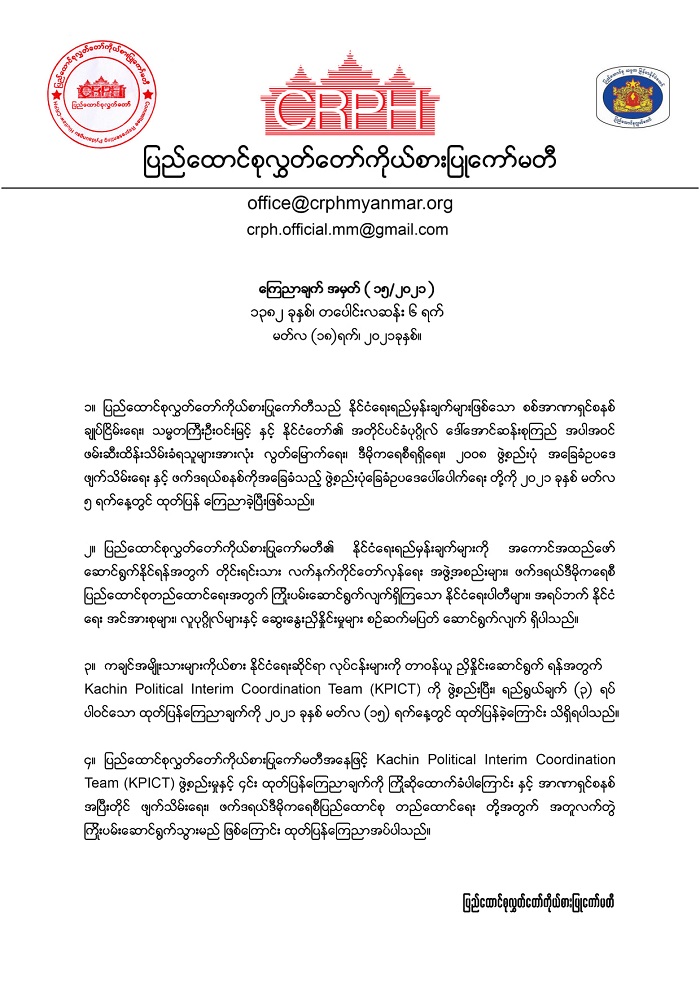
The CRPH is said to be in favor of such consultative councils and committees to cover the non-Bamar ethnic states and their population in joining the NUG. However, it is not clear how it will handle sub-ethnic groups such as Ta’ang or Palaung, Pa-O and Wa, which inhabited the Shan State.
Perspectives
Given such political development the NUG maybe seen as trying to include as many ethnic nationality groups as possible. But the majority and important ministries are occupied by the NLD and the appointment of some ethnic individuals may be cherry picking, although it now tries to solicit the appointed members in the administration to have the backing of ethnic umbrella groups along the line of consultative councils or committees, which were hastily formed to strike the posture that a wide range of concerned ethnic communities are involved, after the NUG formation.
Another point to ponder is that no EAOs have officially endorsed such consultative councils or committees, except the TNLA.
The KNU Brigade 5, which isn’t the whole KNU, has welcomed and vowed to cooperate with the CRPH and CDM movement but still has not endorsed the NUG. The KNU Concerned Group which is not KNU did endorsed the NUG but it is only a watchdog setup with no official bearings.
Thus, all the EAOs, including the FPNCC, except the TNLA has not officially support the NUG. In the same vein, the ethnic political parties have not said anything also on this issue.
In sum, the whole ethnic nationality spectrum is for the uprooting of dictatorship and supportive of the people’s revolution but still not committed to work with the NUG for two reasons.
One is the government line up is not convincing that it caters to the all-inclusiveness war time or revolutionary period administration. Another point is the EAOs may either be watching whether NUG will practice the collective leadership on equal terms after the final federal constitution is drafted or find an alliance type cooperation approach to fight the common enemy, including opting out for a separate political goal rather than the common federal union solution like the AA is driving at.
The NUG’s two-pronged task of forging unity domestically and competing for legitimacy in international arena are intertwined. And in order to be successful the two tasks have to be advanced in tandem. As such, it will only be successful if it could work hand-in-hand with the mainstream EAOs officially either under one banner or as alliance. The liberated area staging ground and the territorial ownership of the EAOs will give the NUG the crucial enforcement power and also physical armed presence in Bamar populated areas with the help of EAOs, which would mean having de jure and de facto legitimacy at the same time. This in turn will help in soliciting the international community and UN for recognition as a legitimate government.
In sum, securing domestic unity through broad-mindedness, accommodation and giving enough incentive so that the EAOs will come onboard are leverages that will help accelerate the success of uprooting the dictatorship and establishment of the desired federal union.



